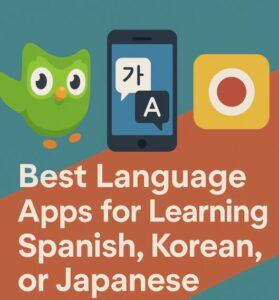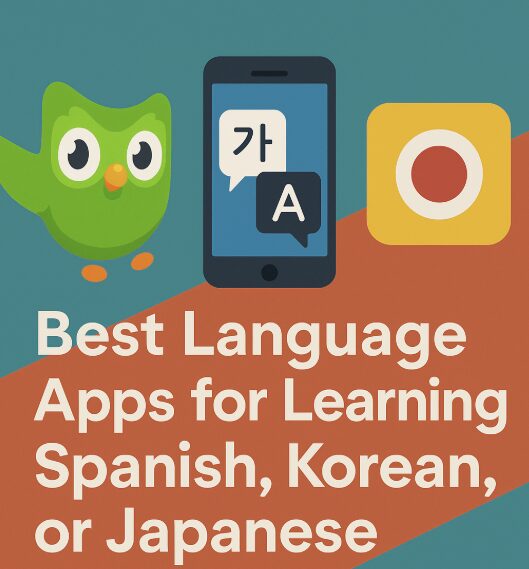If you’re thinking of learning a new language in 2025, you’re not alone. Spanish, Korean, and Japanese are among the most popular languages to learn today—whether it’s to travel, connect with a new culture, or expand your career options. Thanks to the rise of mobile apps and AI-powered platforms, learning a language has never been more accessible.
In this post, we’ll explore the best language learning apps for Spanish, Korean, and Japanese learners, with insights into what makes each one effective and who they’re best for.

Duolingo: Gamified Learning That Keeps You Motivated
Duolingo remains one of the most downloaded language apps worldwide, and for good reason. Its game-style interface and daily streak system make it incredibly easy to build a habit.
Best features:
Bite-sized lessons ideal for beginners
Audio, translation, and speaking exercises
Community competitions and XP streaks
Free version with ads; optional Duolingo Plus subscription
Great for: Total beginners, casual learners, and anyone who wants to stay consistent with minimal effort.
Try it here: Duolingo
Rosetta Stone: Immersive Learning the Old-School Way
Rosetta Stone has been around for decades and has adapted well to the mobile learning environment. It focuses on full immersion—teaching the language in the target language only (no English translation).
Best features:
Real-life imagery with matching audio
Pronunciation practice using TruAccent technology
Structured lesson plans by topic
Available offline
Great for: Learners who prefer a slower, more immersive, traditional approach.
Explore it here: Rosetta Stone
LingQ: Learn From Real-World Content
LingQ is an underrated gem for those who want to learn through reading and listening to natural content. The app offers a huge library of audio with transcripts, ranging from beginner to advanced.
Best features:
Real articles, podcast clips, and stories
Word tracking and spaced repetition
Create flashcards directly from content
Add your own materials (YouTube subtitles, eBooks, etc.)
Great for: Intermediate to advanced learners who want to move beyond textbook-style content.
Check it out: LingQ
LingoDeer: Tailored for Asian Languages
If you’re focused on learning Korean or Japanese, LingoDeer is one of the best apps out there. It was created specifically for Asian languages, with clear grammar explanations and structured lessons.
Best features:
Grammar-focused lessons with native audio
Built-in writing practice (Hangeul, Kanji, Kana)
Offline access and spaced repetition
Clear cultural context explanations
Great for: Beginners to intermediate learners of Korean and Japanese.
Start here: LingoDeer
Pimsleur: Learn by Listening Anywhere
Pimsleur is a long-standing audio-based language course that’s great for learning while commuting or multitasking. It emphasizes spoken language, pronunciation, and listening skills.
Best features:
30-minute audio lessons focused on conversation
Voice recognition for pronunciation
No screen required
Ideal for learning in the car, gym, or while walking
Great for: Learners who absorb information better through audio and want to focus on speaking.
Try it out: Pimsleur
Tandem: Practice With Native Speakers
Tandem connects you with native speakers of your target language for real conversations via text, voice, or video. You teach them your language while they help you with theirs.
Best features:
Language exchange with real people
Built-in correction tools and translation
Filter by country, interests, or goals
Optional professional tutors available
Great for: Learners who want real-life interaction and cultural exchange.
Start practicing: Tandem
Drops: Build Vocabulary Visually
Drops is perfect for learning vocabulary through fast, visual-based sessions. Each lesson takes just five minutes, and the app emphasizes memory retention through repetition.
Best features:
Visual learning without translations
Focus on vocabulary categories (food, travel, business)
Sleek design and engaging UX
Daily five-minute challenge
Great for: Visual learners and those who want to grow their vocabulary quickly.
Check out Drops: Drops
Choosing the Right App for Your Language Goals
There’s no one-size-fits-all when it comes to language learning. The best app for you depends on your current level, learning style, and specific goals. Here’s a quick recommendation guide:
Total beginners: Duolingo, LingoDeer, Rosetta Stone
Audio learners: Pimsleur, Tandem
Grammar lovers: LingoDeer, LingQ
Casual learners: Duolingo, Drops
Cultural immersion seekers: Tandem, LingQ
In fact, combining two or three of these tools often yields the best results. For example, you might use Duolingo for daily practice, LingQ for immersive reading, and Tandem for real conversations.
Whatever language you’re learning, the key is consistency. Commit to just 10–15 minutes a day, and you’ll be surprised at how far you get in a few months.
Start with the app that feels easiest to stick with, then expand from there. Visit Duolingo, Rosetta Stone, or LingQ to take your first step toward fluency today
